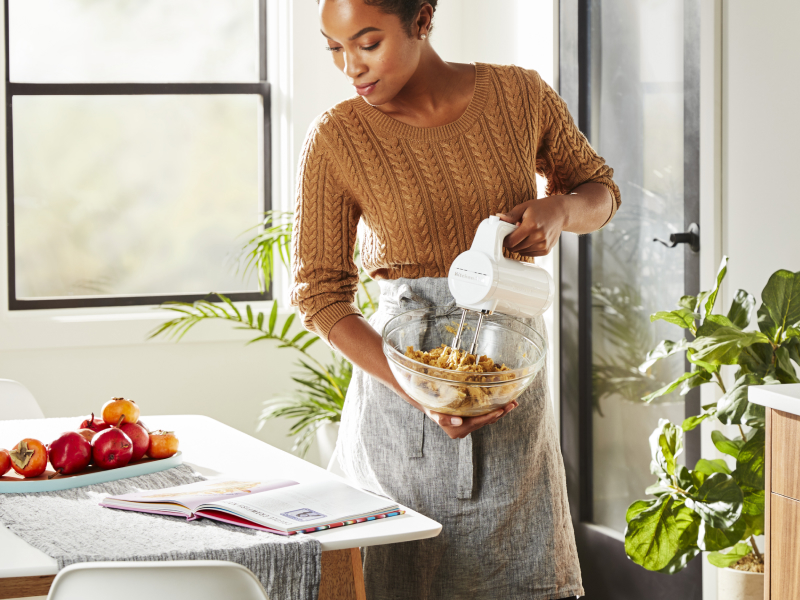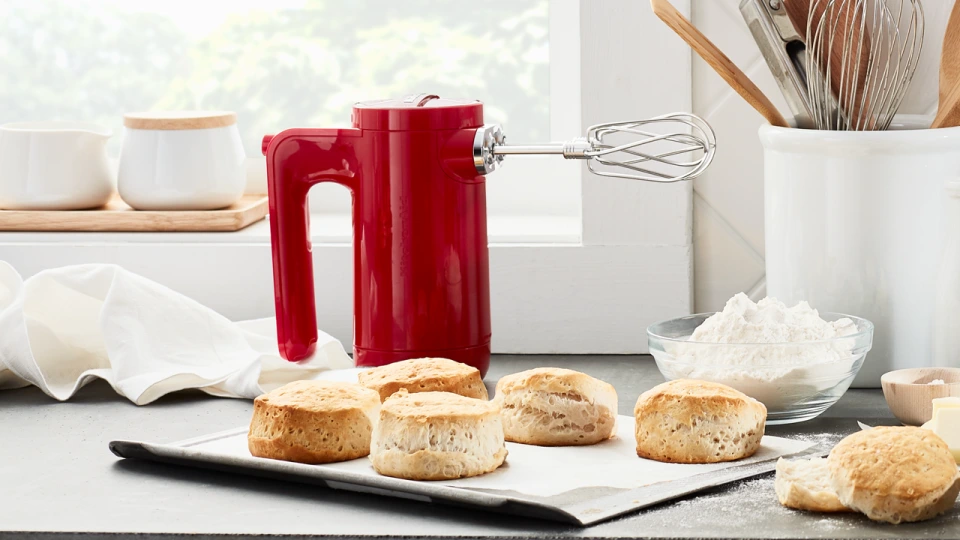Ever been there? You’re ready to whip up some perfect buttercream frosting. You add the powdered sugar, dip your hand mixer in, and flick the switch. In a split second, your kitchen—and your face—is dusted in a fine white cloud. We’ve all had that moment of culinary chaos. If you’ve ever found yourself cleaning batter off the backsplash and wondering if there’s a better way, you’re about to meet your new best friend. So, What Is A Smooth Start Feature? It’s the simple, yet revolutionary, piece of engineering designed to prevent exactly that kind of mess, turning your mixing experience from chaotic to controlled.
This feature is more than just a fancy button; it’s a game-changer for bakers of all levels. It’s the difference between a frustrating clean-up and a seamless, enjoyable creative process. In this guide, we’re going to dive deep into what this feature is, why it’s a non-negotiable for your next hand mixer, and how it will fundamentally change the way you approach mixing in the kitchen.
The Nitty-Gritty: What is a Smooth Start Feature, Exactly?
A smooth start feature is a built-in motor control function in a hand mixer that prevents the beaters from immediately jumping to their full selected speed. Instead, the mixer gradually accelerates over the first few seconds until it reaches the speed you’ve chosen.
Think of it like driving a car. A standard hand mixer is like flooring the gas pedal from a dead stop—you get a jarring lurch and a screech of tires. A hand mixer with a smooth start feature is like gently pressing the accelerator, allowing the car to ease into motion smoothly and without any drama. This gentle ramp-up gives your ingredients a chance to incorporate before the high-speed action begins, keeping flour in the bowl, cream from splashing, and your sanity intact.
How Does It Work Under the Hood?
Without getting too technical, the magic lies in the mixer’s internal circuitry. A small electronic controller regulates the initial flow of power to the motor. Instead of sending a full jolt of electricity at once, it feathers the power in, allowing the motor and the attached beaters to spin up gracefully. This subtle, automated control is what makes the what is a smooth start feature question so relevant for modern bakers who value precision.
The Messy Truth: Why This Feature is a Must-Have
So, it prevents a flour explosion. That’s great, but the benefits run deeper than just cleanliness. A smooth start feature has a profound impact on the quality of your bakes and the longevity of your appliance.
- Ultimate Splatter Control: This is the most obvious benefit. Whether you’re adding cocoa powder to a brownie mix or a splash of milk to mashed potatoes, the gradual start ensures everything stays in the bowl. No more renegade chocolate chips flying across the counter.
- Better Ingredient Incorporation: When you dump dry ingredients on top of wet ones, a sudden jolt from a mixer can create pockets of unmixed flour. A smooth start allows the flour, sugar, or leavening agents to gently fold in first, leading to a more uniform batter and, ultimately, a better-textured final product.
- Protects Delicate Mixtures: Imagine you’ve just spent time carefully whipping egg whites to soft peaks for a meringue. A harsh start can instantly deflate them. The gentle acceleration of a smooth start feature respects the delicate air bubbles you’ve worked so hard to create.
- Longer Motor Life: Just like a car engine, sudden, high-torque starts put a lot of strain on a motor. By easing into the speed, the smooth start feature reduces the initial stress on the motor’s components, which can contribute to a longer lifespan for your beloved hand mixer.
As professional pastry chef Elena Vance once told me, “Control is everything in baking. The smooth start feature gives home bakers a taste of the precision we demand in a professional kitchen. It’s not a luxury; it’s a fundamental tool for better results.”
Beyond the Start: Key Features for Your Next Hand Mixer
While understanding what is a smooth start feature is crucial, it’s one piece of a larger puzzle. To find the perfect hand mixer, you need to consider a few other core components. This is where you graduate from a casual baker to an informed consumer.
Power and Wattage: The Muscle Behind the Mix
Wattage is often seen as the primary measure of power, but it’s more about how much energy the mixer consumes than how much power it outputs. A well-engineered 220-watt motor can easily outperform a poorly designed 300-watt one. Look for mixers from reputable brands that are known for efficient, high-torque DC motors, which provide consistent power even when tackling thick cookie dough.
Speed Settings: From Gentle Folds to High-Speed Whips
A good hand mixer should offer a range of speeds—typically from 3 to 9.
- Low Speeds: Crucial for gently folding in chocolate chips or starting a mix. This works hand-in-hand with the smooth start.
- Medium Speeds: The workhorse speeds for creaming butter and sugar or mixing cake batters.
- High Speeds: Essential for whipping cream into stiff peaks or aerating egg whites for a perfect souffle.
Attachments: The Beaters, Whisks, and Dough Hooks
The attachments are where the action happens. Don’t overlook their design.
- Traditional Beaters: Look for sturdy, stainless steel beaters without a center post. They are far easier to clean and more effective at mixing.
- Whisk Attachment: A balloon whisk is a fantastic addition for maximizing air incorporation when making meringues or whipped cream.
- Dough Hooks: If you plan on making small batches of bread or pizza dough, dough hooks can save your arms a lot of work.
[Find Your Perfect Match in Our Comprehensive Hand Mixer Guide]()
Putting It to the Test: When the Smooth Start Truly Shines
Let’s talk about real-world kitchen scenarios. Where will you be most thankful for this feature?
- Adding Flour to Creamed Butter and Sugar: This is the classic “flour cloud” moment. A smooth start lets you begin mixing without coating your countertops.
- Making Powdered Sugar Frosting: Powdered sugar is notoriously fine and lightweight. The slow ramp-up allows the sugar to moisten and incorporate into the butter or cream cheese before the speed increases, preventing a sugary snowstorm.
- Incorporating Liquids: When you’re adding milk, buttermilk, or water to a batter, a jolt can send liquid splashing everywhere. The smooth start lets you blend it in gently and cleanly.
- Starting a Thick Cookie Dough: Plunging high-speed beaters into a dense dough can make the mixer jump right out of your hands. A smooth start gives the beaters a moment to gain purchase and work their way through the dough without a struggle.
Hand Mixer vs. The Competition: A Quick Showdown
How does a great hand mixer stack up against a stand mixer or a good old-fashioned whisk?
| Feature | Hand Mixer | Stand Mixer | Hand Whisk |
|---|---|---|---|
| Control | High (you direct the beaters) | Medium (bowl-locked) | Maximum |
| Power | Good for most tasks | Excellent for heavy doughs | Relies on your arm strength |
| Convenience | Excellent (small, easy to store) | Poor (heavy, large footprint) | Excellent |
| Best For | Quick bakes, frostings, small batches | Large batches, bread, heavy-duty tasks | Small, quick tasks (eggs, cream) |
A hand mixer with a smooth start feature fills that perfect middle ground—it offers far more power and efficiency than a whisk, with nearly all the convenience, while providing the hands-on control that a stand mixer lacks.
Frequently Asked Questions (FAQ)
Is a smooth start feature the same as a slow start or soft start feature?
Yes, for the most part. Different brands use different marketing terms—”Smooth Start,” “Soft Start,” “Slow Start”—but they all refer to the same core technology: a gradual acceleration of the beaters to prevent splattering and improve control.
Do all modern hand mixers have a smooth start feature?
Not all, but it’s becoming an increasingly common feature, especially in mid-range to high-end models from brands like Cuisinart, KitchenAid, and Breville. It’s a key differentiator that signifies a more thoughtfully designed appliance, so it’s worth looking for.
Can’t I just start on the lowest speed to get the same effect?
You can try, but it’s not the same. Even the lowest speed on a standard mixer can have a significant initial “kick.” The smooth start feature is specifically engineered to ramp up to that lowest speed, offering a level of gentleness that a manual start simply can’t replicate.
Is a smooth start feature really that important for a beginner baker?
Absolutely! In fact, it might be more important for beginners. When you’re just learning, building confidence is key. Avoiding frustrating messes and achieving better-mixed batters from the get-go can make the entire experience more rewarding and encourage you to keep baking.
How do I know if a hand mixer has this feature when I’m shopping?
Manufacturers are proud of this feature, so they usually advertise it clearly on the box and in the product description online. Look for phrases like “Smooth Start,” “splatter-free,” “Soft Start Technology,” or “no-mess mixing” in the product’s feature list.
The Final Whisk
So, what is a smooth start feature? It’s your ticket to a cleaner kitchen, better-incorporated ingredients, and a more controlled, professional-feeling baking process. It’s a small detail that makes a world of difference, elevating a simple hand mixer from a basic tool to a sophisticated culinary partner. The next time you’re in the market for a new mixer, don’t just look at the wattage or the number of attachments. Ask if it has that gentle, intelligent start. Your future self, surrounded by perfectly mixed, splatter-free batter, will thank you.